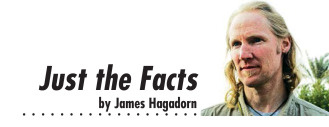 Spring is the zenith of our snow cycle. It’s when the Rockies brim with our most essential economic ingredient—water, in the form of snowpack. The distribution, amount, and melting of this snowpack bodes boom or bust for skiers, growers, fishermen, farmers, and frackers alike—in Colorado and beyond.
Spring is the zenith of our snow cycle. It’s when the Rockies brim with our most essential economic ingredient—water, in the form of snowpack. The distribution, amount, and melting of this snowpack bodes boom or bust for skiers, growers, fishermen, farmers, and frackers alike—in Colorado and beyond.
It all starts with the snow. And our snow is special.
Sourced mostly from evaporating oceans, it’s born when moist, saturated air rises over the Rockies, cools, and encounters windblown dust and other microscopic particles. Snow crystals form when water vapor solidifies around these particles.
As ice crystals in the sky grow, they become heavier and fall earthward. En route they often collide, melt, refreeze, or combine to form all sorts of snowflakes. Like down feathers in a puff jacket, the snowflakes have air trapped between their snow crystals, giving them insulation-like properties. Our snow is also dry.
Wait a sec. If snow is formed from water, how can it be dry?

A family goes for a walk in Stapleton during a 2006 snowstorm. What makes Colorado snow so light, fluffy and fun?
In many parts of the country, snow forms and/or falls in places where the temperatures are close to the freezing point of water (32° F). Under such conditions, crystals within snowflakes may melt a bit as they fall, land, and settle into the snowpack. The melted water becomes trapped or frozen in between unmelted snow crystals, making these “warm weather” snowflakes denser and wetter.
Our snow is dry because nearly all our snow falls at high elevations, where air temperatures tend to be well below freezing. Subfreezing conditions help prevent the tiny snow crystals from combining and partially melting as snowflakes settle—this preserves the insulative air spaces between the crystals and leaves less liquid water available to help the crystals stick together. This leads to our glorious champagne “powder,” and buildup of a thick but not-so-dense snowpack.
Yet a foot of Colorado snow doesn’t usually equal a foot-deep puddle of water that we can use. A foot of our finest powder often yields less than an inch of water. For comparison, the “wet” snow that regularly socks the northeastern U.S. typically yields more than twice that amount. Ugh. Every time I shovel our front walkway, I’m grateful for having snow that weighs less than it ought to. Sometimes I even use a broom!
Because much of Colorado is semi-arid, and most of its people and industries are in these areas, the amount of water in our snowpack is incredibly important. Like a giant frozen cistern, the snowpack dribbles water down to these areas, swelling creeks, rivers, and lakes along the way. Meltwater discharge often peaks in June-July, but by cajoling the water through tunnels, irrigation canals and reservoirs, we extend the duration of its influence through dry intervals, and help it reach arid areas of the state.
Without the delayed release of our mountainous reservoir of snow-water, towns from Grand Junction to Greeley would not thrive as they do. Nor would our ranchers or farmers. All of these industries and locations receive more than half their water from melting snow, not to mention that after such water has been taken, four major rivers deliver this snowmelt to other states and Mexico. Thus there’s a horde of snow-techs up in the mountains, monitoring the snow’s water content and accumulation to assess its proclivity to melt. Comparison of these characteristics to historical records of stream flow helps predict how much water will trickle out of the mountains.
As Colorado’s climate warms in the coming decades, ought we think about how this will impact our special snow, and in turn our water? The bark beetles that brown our forests signal that this change is underway—on average our winter low temperatures aren’t as cold as they used to be. Continued tempering of our winters will impact how much and where our snow accumulates, and when and how it melts.
There are some downsides to our snow. Because it doesn’t stick or clump together as easily as wet snow, snowballs and snowmen are harder to make. And no matter how dry it is, our snow still snarls traffic and parking lots.
But mostly our snow is a benefit. Its physical characteristics make it fun for recreation and foster its enormous, year-round impact on the people and industries of Colorado. So next time someone complains about dealing with our latest snowstorm, perhaps we should suggest they relocate to New York or Michigan to gain some perspective. We’ve got it pretty good.
James Hagadorn, Ph.D., is a scientist at the Denver Museum of Nature & Science. Suggestions and comments are welcome at jwhagadorn@dmns.org.

I love how you remind readers that our snow comes from evaporating oceans – we are directly connected to the ocean. Best, Vicki N. Goldstein, Founder of Colorado Ocean Coalition, Coloradoocean.org
I always heard that some of the moisture was lost as it moved east from California and the Northwest.
James Hagadorn responds: True. The interesting thing about CO is that here on the high plains we get snow that comes from the north, south, west, etc. and so the air masses that we receive can have vastly different temperatures and water vapor content. Think: chinook.